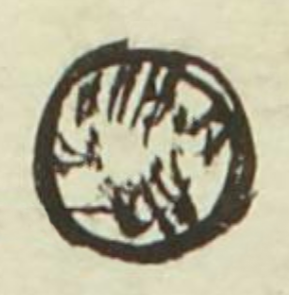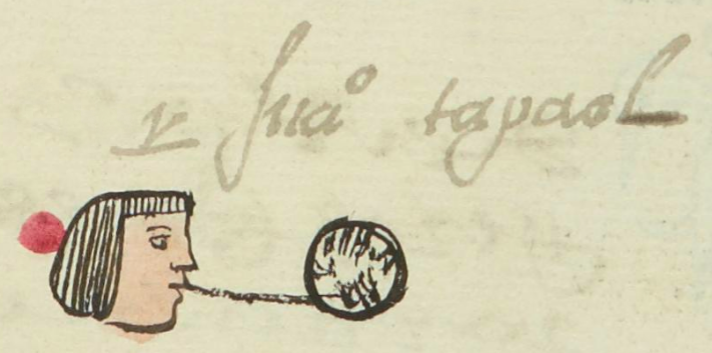Tapayol (MH515v)
This black-line drawing of the simplex glyph for the personal name Tapayol (here, the name of a man) shows a ball (tapayolli). It is a circle with curved lines inside the circle that suggest it is round, three-dimensional.
Stephanie Wood
The Codex Mendoza does not include a ball called the tapayolli; its examples of balls are all black balls of rubber (see below). Molina's Vocabulario has a number of words beginning with tapayol-, and several of them relate to playing a ball game with flowers. Some translations of tapayolli suggest a ball filled with air (see the Gran Diccionario Náhuatl). An air-filled ball could represent a European introduction. A follis, a "pelota de vent" (wind or air ball) was known in Spain in fifteenth and sixteenth centuries (Wikipedia). The Mesoamerican balls were made of solid rubber, a vulcanized latex that was first developed in Mesoamerica. (Mexicolore has a short article on this process and another article with wonderful photos of rubber balls that date from 1,000 years B.C.E.
Stephanie Wood
1560
Jeff Haskett-Wood
bolas, pelotas, balls

tapayol(li), ball, https://nahuatl.wired-humanities.org/content/tapayolli
tpayollalaza, a ball game played with flowers, https://nahuatl.wired-humanities.org/content/tapayollalaza
ol(li<)/em>, rubber, https://nahuatl.wired-humanities.org/content/olli
La Pelota
Matrícula de Huexotzinco, folio 515v, World Digital Library, https://www.loc.gov/resource/gdcwdl.wdl_15282/?sp=110&st=image
This manuscript is hosted by the Library of Congress and the World Digital Library; used here with the Creative Commons, “Attribution-NonCommercial-ShareAlike 3.0 License” (CC-BY-NC-SAq 3.0).



